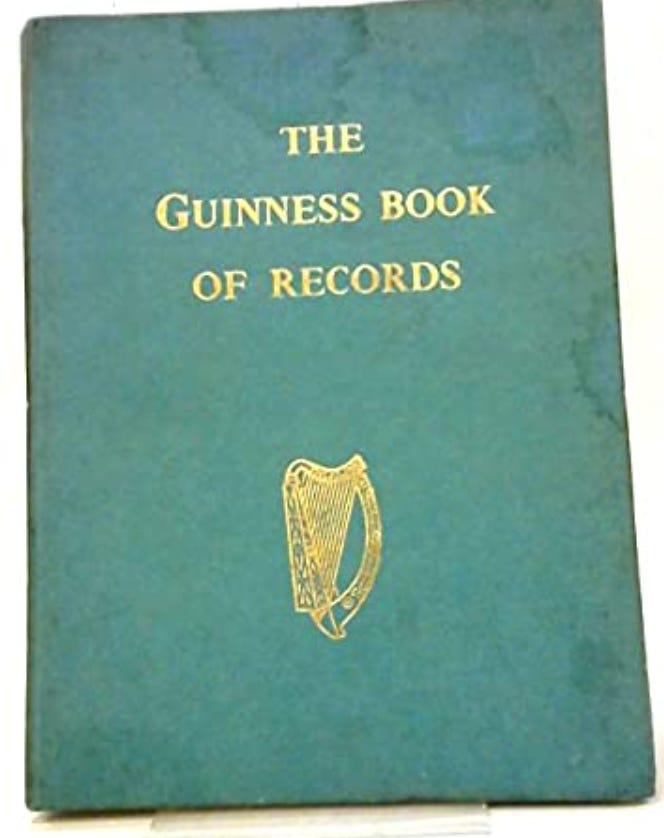“The Last Swim of Summer” by Faith Shearin from Moving the Piano. © Stephen F. Austin State University Press, 2011
ORIGINAL TEXT and AUDIO - 2017
The first edition of the Guinness Book of World Records was published on this date in 1955. The idea for the book had come four years earlier, when Sir Hugh Beaver, the managing director of the Guinness Brewery, was hunting birds in Ireland. He missed a shot at a golden plover, which led to an argument among his friends over which was faster, the golden plover or the red grouse. Beaver considered creating a book that could be consulted during similar debates that often cropped up over a round of drinks. He figured that Guinness could stamp it with their name and distribute it to pubs for advertising purposes.
Beaver mentioned the idea at work, and one of his employees recommended twin brothers Norris and Ross McWhirter, who ran a fact-finding agency in London. The McWhirters had photographic memories and knew an amazing number of unusual facts. The brothers set to work finding the tallest, oldest, heaviest, fastest — the superlatives in a number of categories; their strategy was to give each record their best guess and then send it out to experts for their input. As one twin said: "We found that people who have a total resistance to giving information often have an irresistible desire to correct other people's impressions." The McWhirters worked 90 hours a week for nearly 14 weeks on the project.
Beaver intended the book solely as a marketing gimmick; he didn't expect to make any money on it. The first edition cost just five shillings, and they printed 50,000 copies. They sold 10,000 copies in the first week alone, and went through three more editions over the next 12 months. It has remained an enormous best-seller, with more than 130 million copies sold, and people go to great lengths to be included for things like hula hooping, egg tossing, and kiwi peeling. The McWhirters stayed on for many years as the book's editors and fact checkers. Ross McWhirter was assassinated by the IRA in 1975, and Norris retired in the mid-1980s.
It's the birthday of philosopher Georg Hegel, born in Stuttgart (1770). He started out as a theologian, particularly interested in how Christianity is a religion based on opposites: sin and salvation, earth and heaven, finite and infinite. He believed that Jesus had emphasized love as the chief virtue because love can bring about the marriage of opposites. Hegel eventually went beyond theology and began to argue that the subject of philosophy is reality, and he hoped to describe how and why human beings create communities and governments, make war, destroy each other's societies, and then build themselves up to do it all over again.
He came up with the concept of dialectic, the idea that all human progress is driven by the conflict between opposites, that each political movement is imperfect and so gives rise to a counter movement that takes control — and that is also imperfect — and gives rise to yet another counter movement, and so on to infinity. Friedrich Engels and Karl Marx argued that the most important dialectic of history was between worker and master, rich and poor, and their ideas led to the birth of communism.
It's the birthday of novelist Theodore Dreiser, born in Terre Haute, Indiana (1871). He grew up poor, one of 10 children, in a family that was regularly involved in scandals — his siblings seemed to be in constant trouble with adultery, unwanted pregnancies, jail time, or alcoholism. Dreiser was quiet and studious. In high school, he had a teacher named Mildred Fielding. She was 35 years old and unmarried, tall and thin with big teeth. She had also grown up poor in a dysfunctional family, and she sympathized with Dreiser at the same time that she recognized his potential. She encouraged his studies and told him to ignore the gossip of his schoolmates; but when he was 16, he was so frustrated by his family's poverty and scandals that he dropped out of school, determined to make it on his own. He set off for Chicago with a change of underwear and socks, and a few dollars.
Two years later, he was working a menial job at a warehouse when his old teacher, Mildred Fielding, found him once again. She was now the principal of a Chicago school, and she insisted on paying for his tuition at Indiana State College in Bloomington. He only stayed for one year, but he said: "If ever […] a year proved an oasis in a life, this one did." He returned to Chicago, where he found work as a reporter and became a prolific writer. He could crank out stories for hours on end, and had a talent for plagiarizing himself. He had never tried to write fiction before the fall of 1899, when he was staying with a friend who convinced him to try writing a novel. Dreiser wrote the novel Sister Carrie (1900) based on the widely publicized scandal of one of his sisters. His other novels include The Financier (1912) and An American Tragedy (1925).
On this day in 1912, the character of Tarzan, King of the Apes, came to life in All-Story Magazine. Tarzan's creator, Edgar Rice Burroughs had failed the entrance exam to the U.S. Military Academy at West Point and fared poorly in other occupations like cowboy, shopkeeper, gold miner, and railroad policemen. It was after devouring a lot of pulp magazines that he tried his hand at writing, believing "if people were paid for writing rot such as I read in some of those magazines, that I could write stories just as rotten. As a matter of fact, although I had never written a story, I knew absolutely that I could write stories just as entertaining and probably a whole lot more so than any I chanced to read in those magazines."
He'd had success with his John Carter stories, which would later be novelized for the first time as The Princess of Mars (1912), but it was the creation of Tarzan, a white baby orphaned in the coastal jungles of Africa and raised by the she-ape Kala, that would make his legacy. Burroughs had considered naming his feral child "Zanter" or "Tublat Zan," but settled on "Tarzan," born John Clayton, son of Lord and Lady Greystoke of England. The name "Tarzan" means "white skin" in ape language. He teaches himself to read when he discovers picture books his parents left behind. And later, when an American gentleman and his daughter, Jane, arrive in the jungle looking for buried treasure, they find Tarzan, who falls instantly in love with Jane.
"Tarzan of the Apes: A Romance of the Jungle" was a hit. Two years later, in 1914, Burroughs' story of a tall, gray-eyed, athletic man who can swing from vines, kill an ape, fill out a loincloth, and wield a knife with expert precision was published as the novel Tarzan of the Apes and became an instant sensation, spawning 24 more Tarzan novels and more than 40 films. The first Tarzan movie was made in 1917 and grossed over a million dollars. Burroughs was a consummate businessman, controlling the rights and licensing to all things Tarzan-related, like television shows, comic books, radio shows, jackknives, and even multivitamins.
The Tarzan novels had a profound impact on pop culture and science. Anthropologist and primatologist Jane Goodall, renowned for her work with chimpanzees, began reading the books when she was 11 and credits them with inspiring her determination to work in Africa. She said: "I fell passionately in love with Tarzan — this glorious creature living out in the jungle doing all the things I wanted to do, and what did he do? He married the wrong Jane."
Science fiction writer Ray Bradbury spent his childhood memorizing passages from the Tarzan novels and reciting them to his friends. He said, "Burroughs is probably the most influential writer in the history of the world."
In the novels, Tarzan is well-spoken and thoughtful. Burroughs didn't care for the film versions, which made Tarzan out to be a rough-hewn semiliterate, reciting lines like, "Me, Tarzan, you, Jane," which he never says in the books.
In the course of 24 Tarzan novels written by Edgar Rice Burroughs, Tarzan finds remnants of the Roman Empire hidden in the mountains of Africa; prevents Russian communists from looting the lost city of Opar; stumbles upon a real-life Jurassic Park filled with angry dinosaurs; travels to Baltimore, Maryland, to win Jane's hand in marriage; and runs afoul of the Veltopismakusian scientist Zoanthrohago, who reduces him to one-fourth of his normal size.
Edgar Rice Burroughs made so much money from the character of Tarzan that he formed his own publishing house and bought 550-acres of land east of Los Angeles and called it "Tarzana Ranch." Today, it is known as the city of Tarzana.
It's the birthday of Ira Levin, author, dramatist, and songwriter. He was born in New York City in 1929. For the first 13 years of his life, his family lived in the Bronx, but as their toy business prospered, they moved to the Upper West Side of Manhattan. His first produced play was No Time for Sergeants (1956), which was about a Southern country boy in the U.S. Marines. Many of his novels were made into movies, sometimes multiple times, including A Kiss Before Dying(1953), The Stepford Wives (1972), The Boys from Brazil (1976), and his best known, Rosemary's Baby (1967). His play Deathtrap (1978) ran for nearly 1,800 performances on Broadway. His works were never held up as masterpieces of literary fiction, but they provided a good thrill, and sometimes a chill, and inspired the likes of Stephen King, who once called Levin "the Swiss watchmaker of suspense novels," and added, "He makes what the rest of us do look like cheap watchmakers in drugstores."






LAST TIME ROOT
ROUTE RANGE SONG
from the overinfluences
that go back through
those and before those
underinfluenced away
back to the blank slates
in pale bluish lustery
lavender bluegreen
then going forward
through surrender
birth starting bald
then hairy silly foolish
developments beginning
all those crazy crazed
years futured, functioning
transparent mindwalking
before clouds thicken as
we being understanding
history backing each
our panes of glass* when
each me is i then you,
live monster bellies we
brutalized, brutalizing
in our by our lifetimes
not in right minds to
survey, repair damage
_____________________________________
*We start transparent, and then the cloud thickens. All history back our pane of glass….
--Virginia Woolf, JACOB’S ROOM, Hogarth Press, 1922, London
© Copyright Edward Mycue 9am Sunday August 27, 2023
“Veltopismakusian.”
The what now? 🤔